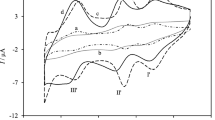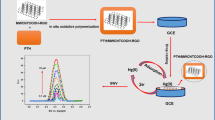Abstract
In this study, 3-(2-Aminoethyl thiophene) (2AET) monomer was electropolymerized on glassy carbon electrode (GCE) using various electrolytes (lithium perchlorate (LiClO4), sodium perchlorate (NaClO4), tetrabutyl ammonium tetra fluoroborate (TBABF4) and tetraethyl ammonium tetra fluoroborate (TEABF4) in acetonitrile (CH3CN) as solvent. Poly(3-(2-aminoethyl thiophene) (P(2AET))/GCE was characterized by cyclic voltammetry (CV), Fourier transform infrared reflectance spectrophotometry (FTIR-ATR), scanning electron microscopy, energy dispersive X-ray analysis (EDX), and electrochemical impedance spectroscopy (EIS) techniques. The electrochemical impedance spectroscopic results were given by Nyquist, Bode-magnitude, Bode-phase, capacitance and admittance plots. The highest low frequency capacitance (C LF) value obtained was 0.65 mF cm−2 in 0.1 M LiClO4/CH3CN for the initial monomer concentration of 1.5 mM. The highest double layer capacitance (C dl = ~0.63 mF cm−2) was obtained in 0.1 M LiClO4/ACN for [2AET]0 = 0.5, 1.0 and 1.5 mM. The maximum phase angles (θ = 76.1o at 26.57 Hz) and conductivity (Y″ = 3.5 mS) were obtained in TEABF4/ACN for [2AET]0 = 0.5 and 1.0 mM, respectively. An equivalent circuit model of R(Q(R(Q(R(CR))))) was simulated for different electrolytes (LiClO4, NaClO4, TBABF4 and TEABF4)/P(2AET)/GCE system. A good fitting was obtained for the calculated experimental and theoretical EIS measurement results. The electroactivity of P(2AET)/GCE opens the possibility of using modified coated electrodes for electrochemical micro-capacitor electrodes and biosensor applications.









Similar content being viewed by others
References
Heth CL, Tallman DE, Rasmussen SC (2010) Electrochemical study of 3-(N-alkylamino)thiophenes: experimental and theoretical insights into a unique mechanism of oxidative polymerization. J Phys Chem B 114:5275–5282
Beaujuge PM, Amb CM, Reynolds JR (2010) Spectral engineering in π-conjugated polymers with intramolecular donor-acceptor interactions. Acc Chem Res 43:1396–1407
Roncali J (1992) Conjugated poly(thiophenes): synthesis, functionalization, and applications. Chem Rev 92:711–738
McCullough RD (1998) The chemistry of conducting polythiophenes. Adv Mater 10:93–116
Koyuncu FB, Koyuncu S, Ozdemir E (2011) A new multi-electrochromic 2,7-linked polycarbazole derivative: effect of the nitro subunit. Org Electron 12:1701–1710
Zhang K, Tieke B, Forgie JC, Skabara PJ (2009) Electrochemical polymerisation of N-Arylated and N-Alkylated EDOT-substituted pyrrolo[3,4-c] pyrrole-1,4-dione (DPP) derivatives:influence of substitution pattern on optical and electronic properties. Macromol Rapid Commun 30:1834–1840
Irvin JA, Irvin DJ, Stenger-Smith JD (2007) Electroactive polymers for batteries and supercapacitors. In: Handbook of conjugated polymers: processing and applications, Skotheim TA, Reynolds JR (Eds), 3rd edn, CRC Press, Boca Raton
Roncali J (1999) Electrogenerated functional conjugated polymers as advanced electrode materials. J Mater Chem 9:1875–1893
Naudin E, Ho HA, Branchaud S, Breau L, Bélanger D (2002) Electrochemical polymerization and characterization of poly(3-(4-fluorophenyl)thiophene) in pure ionic liquids. J Phys Chem B 106:10585–10593
Beaujuge PM, Ellinger S, Reynolds JR (2008) The donor-acceptor approach allows a black to transmissive switching polymeric electrochrome. Nat Mater 7:795–799
Chang C-H, Wang K-L, Jiang J-C, Liaw D-J, Lee K-R, Lai J-Y, Lai K-H (2010) Novel rapid switching and bleaching electrochromic polyimides containing triarylamine with 2-phenyl-2-isopropyl groups. Polymer 51:4493–4502
Goto H, Kawabata K (2011) Light driven asymmetric polymerization: an approach for tele-control reaction. Polym Chem 2:1098–1106
Goto H (2012) Electrochemical polymerization in crystal—preparation of polybithiophene with crystal order. J Polym Sci Part A Polym Chem 50:622–628
Kiani GR, Arsalani N, Entezami AA (2001) The influence of the catalytic amount of 1-(2-pyrrolyl)-2-(2-thienyl)ethylene and 2-(2-thienyl)pyrrole on electropolymerization of pyrrole and N-methylpyrrole. Iran Polym J 10:135–142
Tam PD, Van Hieu N (2011) Conducting polymer film-based immunosensor using carbon nanotube/antibodies doped polypyrrole. Appl Surf Sci 257:9817–9824
Ates M, Yilmaz K, Shahryari A, Omanovic S, Sarac AS (2008) A study of the electrochemical behavior of poly(N-vinylcarbazole) formed on carbon fiber microelectrodes and its response to dopamine. IEEE Sensors J 8:1628–1639
Ates M, Sarac AS, Turhan CM, Ayaz NE (2009) Polycarbazole modified carbon fiber microelectrode: surface characterization and dopamine sensor. Fiber Polym 10:46–52
Ates M, Castillo J, Sarac AS, Schuhmann W (2008) Carbon fiber microelectrodes electrocoated with polycarbazole and poly(carbazole-co-p-tolylsulfonyl pyrrole) P(Cz-co-p Tsp) films for the detection of dopamine in presence of ascorbic acid. Microchim Acta 160:247–251
Gómez H, Ram MK, Alvi F, Villalba P, Stefanakos E, Kumar A (2011) Graphene-conducting polymer nanocomposite as novel electrode for supercapacitors. J Power Sources 196:4102–4108
Zhou Y, Qin Z-Y, Li L, Zhang Y, Wei Y-L, Wang L-F, Zhu M-F (2010) Polyaniline/multi-walled carbon nanotube composites with core-shell structures as supercapacitor electrode materials. Electrochim Acta 55:3904–3908
Wang J, Xu Y, Chen X, Du X (2007) Electrochemical supercapacitor electrode material based on poly(3,4-ethylenedioxythiophene) polypyrrole composite. J Power Sources 163:1120–1125
Selvakumar M, Pitchumani S (2010) Hybrid supercapacitor based on poly(aniline-co-m-anilicacid) and activated carbon in non-aqueous electrolyte. Korean J Chem Eng 27:977–982
Zou J, Yip H-L, Hau SK, Jen AK-Y (2010) Metal grid/conducting polymer hybrid transparent electrode for inverted polymer solar cells. Appl Phys Let 96:203301–203303
Ma C, Xu Y, Zhang C, Xu Y, Xiang W, Ouyang M (2009) Electrochemical polymerization of a beta–beta linkages polythiophene derivative based on 2,5-diphenyl-thiophene. J Electroanal Chem 634:31–34
Borrelli DC, Barr MC, Bulović V, Gleason KK (2012) Bilayer heterojunction polymer solar cells using unsubstituted polythiophene via oxidative chemical vapor deposition. Sol Energ Mat Sol C 99:190–196
Sivaraman P, Mishra SP, Bhattacharrya AR, Thakur A, Shashidhara K, Samui AB (2012) Effect of regioregularity on specific capacitance of poly(3-hexylthiophene). Electrochim Acta 69:134–138
Anglin TC, Speros JC, Massari AM (2011) Interfacial ring orientation in polythiophene field-effect transistors on functionalized dielectrics. J Phys Chem C 115:16027–16036
Jonas F, Schrader L (1991) Conductive modifications of polymers with polypyrroles and polythiophenes. Synth Met 41:831–836
Kiani GR, Sheikhloie H, Rostami A (2011) Highly enhanced electrical conductivity and thermal stability of polythiophene/single-walled carbon nanotubes nanocomposite. Iran Polym J 20:623–632
Bushueva AY, Shklyaeva EV, Abashev GG (2009) New pyrimidines incorporating thiophene and pyrrole moieties: synthesis and electrochemical polymerization. Mendeleev Commun 19:329–331
Groenendaal BL, Jonas F, Freitag D, Pielartzik H, Reynolds JR (2000) Poly(3,4-ethylenedioxythiophene) and its derivatives: past, present and future. Adv Mater 12:481–494
Roncali J (1997) Synthetic principles for band gap control in linear pi-conjugated systems. Chem Rev 97:173–205
Granstrom M (1997) Polym novel polymer light-emitting diode designs using poly(thiophenes). Polym Adv Technol 8:424–430
Higgins TB, Mirkin CA (1998) Model coordination complexes for designing poly(terthiophene)/Rh(I) hybrid materials with electrochemically tunable reactivities. Chem Mater 10:1589–1595
Jadamiec M, Lapkowski M, Matlengiewicz M, Brembilla A, Henry B, Rodehüser L (2007) Electrochemical and spectroelectrochemical evidence of dimerization and oligomerization during the polymerization of terthiophenes. Electrochim Acta 52:6146–6154
Chan HSO, Ng SC (1998) Synthesis, characterization and applications of thiophene-based functional polymers. Prog Polym Sci 23:1167–1231
Barbarella G, Melucci M, Sotgiu G (2005) The versatile thiophene: an overview of recent research on thiophene-based materials. Adv Mater 17:1581–1593
Jen K-Y, Miller GG, Elsenbaumer RL (1986) Highly conducting, soluble, and environmentally-stable poly(3-alkylthiophenes). J Chem Soc Chem Commun 17:1346–1347
Armelin E, Bertran O, Estrany F, Salvatella R, Alemán C (2009) Characterization and properties of a polythiophene with a malonic acid dimethyl ester side group. Eur Polym J 45:2211–2221
Scully JR, Silverman DC, Kendig MV (1993) Electrochemical impedance: analysis and interpretation. ASTM Int, Philadelphia
Darowicki K, Kawula J (2004) Impedance characterization of the process of polyaniline first redox transformation after aniline electropolymerization. Electrochim Acta 49:4829–4839
Baldissera AF, Freitas DB, Ferreira CA (2010) Electrochemical impedance spectroscopy investigation of chlorinated rubber-based coatings containing polyaniline as anticorrosion agent. Mater Corros 61:790–801
Wang X, Bernard MC, Deslouis C, Joiret S, Rousseau P (2010) A new transfer function in electrochemistry: dynamic coupling between Raman spectroscopy and electrochemical impedance spectroscopy. Electrochim Acta 55:6299–6307
Jannakoudakis PD, Pagalos N (1994) Electrochemical characteristics of anodically prepared conducting polyaniline films on carbon fiber supports. Synth Met 68:17–31
Ferloni P, Mastragostino M, Meneghello L (1996) Impedance analysis of electronically conducting polymers. Electrochim Acta 41:27–33
Simoes FR, Pocrifka LA, Marchesi LFQP, Pereira EC (2011) Investigation of electrochemical degradation process in polyaniline/polystyrene sulfonated self-assembly films by impedance spectroscopy. J Phys Chem B 115:11092–11097
Agrisuelas J, Gabrielli C, García-Jareño JJ, Giménez-Romero D, Perrot H, Vicente FJ (2007) Spectroelectrochemical identification of the active sites for protons and anions insertions into poly(azure a) thin polymer films. J Phys Chem C 111:14230–14237
Amemiya T, Hashimoto K, Fujishima A (1993) Faradaic charge-transfer with double-layer charging and/or adsorption related charging at polymer-modified electrodes as observed by color impedance spectroscopy. J Phys Chem 97:9736–9740
Agrisuelas J, García- Jareño JJ, Giménez-Romero D, Vicente F (2010) An approach to the electrochemical activity of poly-(phenothiazines) by complementary electrochemical impedance spectroscopy and Vis-NIR spectroscopy. Electrochim Acta 55:6128–6135
Manickam A, Chevalier A, McDermott M, Ellington AD, Hassibi A (2010) A CMOS electrochemical impedance spectroscopy (EIS) biosensor array. IEEE Trans Biomed Circuits Syst 4:379–390
Edge S, Charlton A, Varma KS, Hansen TK, Underhill AE, Kathirgamanathan P, Berger J, Simonson O (1993) The preparation and properties of maleimide derivatives of 3-(2-aminoethyl)thiophene. Synth Met 53:315–324
Era M, Yoneda S, Sano T, Noto M (2003) Preparation of amphiphilic poly(thiophene)s and their application for the construction of organic-inorganic superlattices. Thin Solid Films 438:322–325
Murray RW, Ewing AG, Durst RA (1987) Chemically modified electrodes: molecular design for electrocatalysis. Anal Chem 59:379–390
Anson FC, Ni CL, Saveant JM (1985) Eelectrocatalysis at redox polymer electrodes with separation of the catalytic and charge propogation roles. Reduction of O2 to H2O2 as catalyzed by cobalt (II) tetrakis (4-N-methylpyridyl)porphyrin. J Am Chem Soc 107:3442–3450
Skotheim TA, Reynolds J (eds) (2007) Hanbook of conducting polymers, vols 1 and 2, 3rd edn. CRC Press, Boca Raton
Ding KQ, Wang Q, Jia Z, Tong R, Wang X, Shao H (2003) Impedance description of the effect of the polar potential on a Schiff base self-assembled monolayer. J Chin Chem Soc 50:387–394
Saraç AS, Gilsing H-D, Gencturk A, Schulz B (2007) Electrochemically polymerized 2,2-dimethyl-3,4-propylenedioxythiophene on carbon fiber for microsupercapacitor. Prog Org Coat 60:281–286
Sezer E, Ustamehmetoğlu B, Saraç AS (1999) Chemical and electrochemical polymerization of pyrrole in the presence of N-substituted carbazoles. Synth Met 107:7–17
Bates JB, Wang JC, Anderson RL (1984) In: Proceedings of the ECS Fall meeting, extented abstracts, New Orleans, 84:233–237
Le Mehaute A, Crepy G (1993) Introduction to transfer and motion in fractal media: the geometry of kinetics. Solid State Ionics 9–10:17–30
Tanguy J, Baudoin JL, Chao F, Costa M (1992) Study of the redox mechanism of poly-3-methylthiophene by impedance spectroscopy. Electrochim Acta 37:1417–1428
Refaey SAM (2004) Electrochemical impedance studies on the electrochemical properties of poly(3-methylthiophene) in aqueous solutions. Synth Met 140:87–94
Acknowledgments
Financial support for this work by the Research Foundation of Namik Kemal University (Turkey) project number: NKU.BAP.00.10.AR.11.01) is gratefully acknowledged.
Author information
Authors and Affiliations
Corresponding author
Rights and permissions
About this article
Cite this article
Ates, M., Karazehir, T., Arican, F. et al. Electrolyte type and concentration effects on poly(3-(2- aminoethyl thiophene) electro-coated on glassy carbon electrode via impedimetric study. Iran Polym J 22, 199–208 (2013). https://doi.org/10.1007/s13726-012-0117-z
Received:
Accepted:
Published:
Issue Date:
DOI: https://doi.org/10.1007/s13726-012-0117-z




